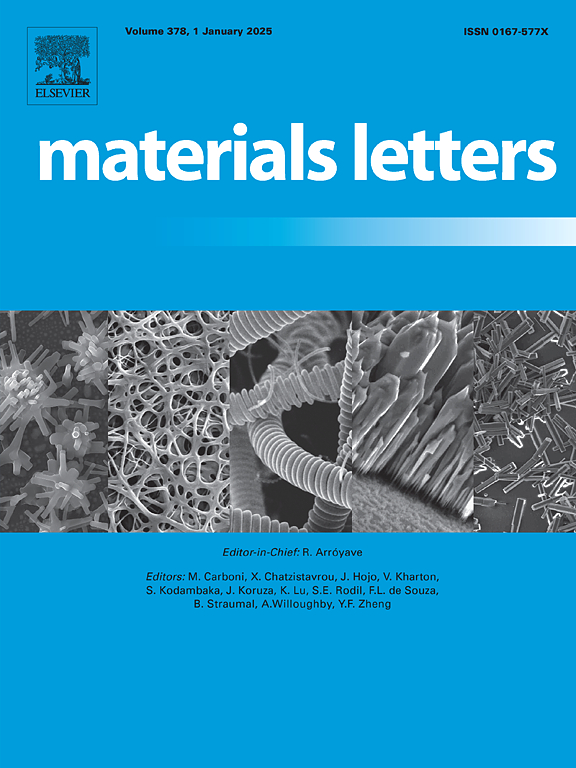水浴冷却和超声波振动辅助 CMT 线弧定向能沉积镁合金微观结构和机械性能的比较研究
IF 2.7
4区 材料科学
Q3 MATERIALS SCIENCE, MULTIDISCIPLINARY
引用次数: 0
摘要
本研究调查了水浴冷却和层间超声波振动对通过基于冷金属转移的线弧快速成型制造(CMT-WAAM)生产的镁合金(AZ31)部件的影响。结果表明,与空气冷却相比,水浴冷却对细化晶粒尺寸或改善机械性能的影响很小。相比之下,层间超声波振动处理可显著细化晶粒尺寸 36.8%,这是由于超声波振动产生了空化和声流效应。经过超声波振动处理的试样具有更高的机械性能,屈服强度达 73 兆帕,极限拉伸强度达 220 兆帕,伸长率达 20%。强度-电导率协同作用的改善归因于超声波振动处理引起的晶粒细化和细小析出物的均匀分布。这些发现表明,层间超声波振动处理是提高 CMT WAAM 制备的镁合金机械性能的有效方法。本文章由计算机程序翻译,如有差异,请以英文原文为准。
Comparative study on microstructure and mechanical properties of CMT wire-arc directed energy deposited magnesium alloy assisted by water bath cooling and ultrasonic vibration
This study investigates the effects of water bath cooling and interlayer ultrasonic vibration on magnesium alloy (AZ31) components produced through cold metal transfer-based wire arc additive manufacturing (CMT-WAAM). The results showed that water bath cooling had little impact on refining grain size or improving mechanical properties compared to air cooling. In contrast, interlayer ultrasonic vibration treatment significantly refined grain size by 36.8 %, due to cavitation and acoustic streaming effects caused by ultrasonic vibrations. Ultrasonic vibration-treated specimens exhibited enhanced mechanical properties, with yield strength of ∼73 MPa, ultimate tensile strength of ∼220 MPa, and elongation of ∼20 %. The improved strength-ductility synergy was attributed to refinement of grain size and uniform distribution of fine precipitates induced by ultrasonic vibration treatment. These finding suggests that interlayer ultrasonic vibration treatment is an effective method for enhancing the mechanical properties of CMT WAAM-prepared magnesium alloys.
求助全文
通过发布文献求助,成功后即可免费获取论文全文。
去求助
来源期刊

Materials Letters
工程技术-材料科学:综合
CiteScore
5.60
自引率
3.30%
发文量
1948
审稿时长
50 days
期刊介绍:
Materials Letters has an open access mirror journal Materials Letters: X, sharing the same aims and scope, editorial team, submission system and rigorous peer review.
Materials Letters is dedicated to publishing novel, cutting edge reports of broad interest to the materials community. The journal provides a forum for materials scientists and engineers, physicists, and chemists to rapidly communicate on the most important topics in the field of materials.
Contributions include, but are not limited to, a variety of topics such as:
• Materials - Metals and alloys, amorphous solids, ceramics, composites, polymers, semiconductors
• Applications - Structural, opto-electronic, magnetic, medical, MEMS, sensors, smart
• Characterization - Analytical, microscopy, scanning probes, nanoscopic, optical, electrical, magnetic, acoustic, spectroscopic, diffraction
• Novel Materials - Micro and nanostructures (nanowires, nanotubes, nanoparticles), nanocomposites, thin films, superlattices, quantum dots.
• Processing - Crystal growth, thin film processing, sol-gel processing, mechanical processing, assembly, nanocrystalline processing.
• Properties - Mechanical, magnetic, optical, electrical, ferroelectric, thermal, interfacial, transport, thermodynamic
• Synthesis - Quenching, solid state, solidification, solution synthesis, vapor deposition, high pressure, explosive
 求助内容:
求助内容: 应助结果提醒方式:
应助结果提醒方式:


